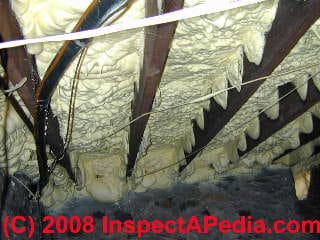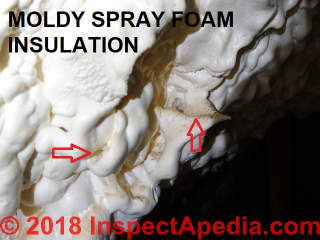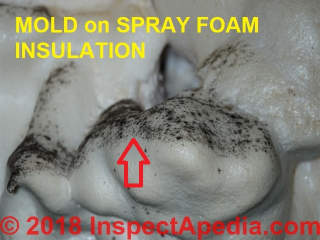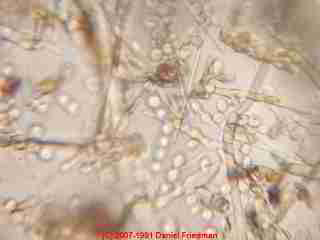 Mold Risk in Foam Insulation
Mold Risk in Foam Insulation
Foam insulation is mold resistant but NOT mold-proof
- POST a QUESTION or COMMENT about the level of mold resistance of foam building insulation products
Mold resistance of foam insulation products:
This document provides information about the cause, detection, and hazards of mold growth in foam insulating materials in comparison with fiberglass insulation in residential and light-commercial buildings.
This website discusses health hazards associated with mold in buildings.
InspectAPedia tolerates no conflicts of interest. We have no relationship with advertisers, products, or services discussed at this website.
- Daniel Friedman, Publisher/Editor/Author - See WHO ARE WE?
What are the Comparable Risks of Mold Growth in Foam Insulation vs. in Fiberglass Building Insulation?
Foam building insulation, in both spray foam and foam board products, is resistant to mold growth but as we will explain here it is not absolutely mold-roof, and on occasion we do find mold growth on the surface of even closed-cell foam, in open-celled foam (rare), and on th surface of EPS and other foam insulating board products (uncommon).
The following opinions about mold risk associated with different types of insulating products in buildings are based on 40 years of field investigation experience and 20 years of forensic laboratory experience and the results appear intuitive, unambiguous, and compelling.
However we add that controlled authoritative research on this question has not been completed and additional factors may be involved. The authors have no financial nor any other relationship with products or services discussed at this website.
Photos above and below show two different types of mold growth on the surface of foam building insulation.
[Click to enlarge any image]
A web search for "clean mold from foam insulation" such as one we conducted last on 10/16/2018 as an update to this article typically finds the following OPINION articles
- A foamy sea of foam insulation companies explaining why foam insulation is mold-proof
- A writer saying that because foam seals perfectly there will be no air leaks so no foam growth - without supporting, independent, authoritative research
- A writer saying remove the moldy foam, take it outside, crush it up, and toss it away (suitable for a foam couch cushion but not for sprayed-in building insulation)
Lower Mold Risk Seen with Solid Insulation Products than with Open Products such as Fiberglass
In general, we find fiberglass a ready mold harbor and we do not find mold in foam insulation products such as spray-on Icynene foam insulation or in foam insulating boards.
Closed cell foam insulation does not pick up moisture nor organic dust so it is less friendly to mold growth within itself.
Mold growth resistance of Icynene foam insulation: quoting from Icynene Inc.:
A preemptive solution [to building mold growth] that would reduce the infiltration of moisture would be the application of a seamless, monolithic spray foam insulation and air barrier system that conforms to complex design shapes while sealing around penetrations such as pipes, windows, doors and electrical boxes.
Not only will this help in reducing potential sources of mold, it will also minimize the infiltration of outdoor pollutants and allergens.
Other sources of mold resistance with foam insulating products
We speculate that there may be a further mold resistance when using a spray-in foam insulation product insofar as the foam forms a tight bond between the foam and the sprayed-on surface such as the sides of rafters or wall studs or floor joists and the underside of roof, wall, or floor sheathing.
This tightness may resist moisture passage into the building cavity and thus substantially reduce the chances of mold growth on wood or other organic surfaces in those areas.
Finally, the installation of an insulation product which is less leaky around wall penetrations, such as receptacles, switches, light fixtures, windows, doors, will move less air through the building cavities and thus would be expected to move less moisture through those spaces, also reducing the probability of a mold problem therein.
Closed cell foams keep out moisture and may be chemically resistant to mold
If we expose any closed cell foam to the same conditions, because moisture and particles do not enter its interior, it is resistant to becoming a mold reservoir itself.
It is possible that the chemistry of some foam insulations is also mold-resistant, just as I’ve observed that blown-in cellulose insulation is mold resistant, probably because of the chemistry of the fire retardant with which it is treated.
Open celled insulation products and fiberglass appear more friendly to mold growth
If we expose fiberglass to water, leaks, or high moisture there is a risk of mold growth within the insulation itself as well as on surfaces of the cavity where it resides.
The level of risk of mold in fiberglass depends on many factors such as the age of the insulation, the amount of organic dust and debris in its environment, the level of moisture to which it is exposed, and other variables.
Factors that Encourage Mold Growth on or in Foam Insulation
 While the chemistry of all foam insulating products is probably not highly conducive to mold growth (neither is fiberglass insulation) we will find mold growth on these insulating products when any of the following are present:
While the chemistry of all foam insulating products is probably not highly conducive to mold growth (neither is fiberglass insulation) we will find mold growth on these insulating products when any of the following are present:
- There is moisture present in or on the insulating material
- There are air leaks in the spray foam insulation - at FOAM SPRAY INSULATION TYPES we warn about inexpert application of spray foam that leaves gaps, holes, air leaks.
Building air movement through such openings may bring moisture as well as organic dust that invite mold growth. - There is organic material, possibly simple house dust (dominated by fabric fibers and skin cells) on the surface of the insulation - something the particular mold genera likes to eat
- There is another, more-significant mold reservoir in the building.
We have found, in particular, surprising levels of mold contamination on and in fiberglass insulation and more rarely on foam insulation, when there was already a high level of airborne mold in a building.We have measured very high levels of airborne problematic mold spores which were traced to a building reservoir of moldy fiberglass insulation.
See FIBERGLASS INSULATION MOLD for details.
Photo above: yellow mold growth on spray foam insulation observed by M. Cramer in a Florida home.
What Mold, Rot,or Damage Concerns Occur When Using Foam Insulation In buildings?
Closed building cavities may be at risk of rot or mold from external leaks
There is one fly in the ointment of this insulation mold balm, however. In some locations, perhaps such as a cathedral ceiling, a leak from the building exterior that penetrates the cavity will send water in to a location where it is both hard to detect and slow to dry out.
The result can be severe rot and structural damage where undetected leaks into the building envelope occur. We ’ve seen this in particular in some of the “hot roof” designs on newer homes.
Mold risk is higher on EIFS or Synthetic Stucco Covered buildings
We’ve seen this trapped-moisture problem along with mold problems in extreme where a different foam insulation approach was used: the construction of synthetic stucco building exteriors (EIFS). In this last example, leaks at wall penetrations of synthetic-stucco-covered buildings (using the EIFS system) send water behind foam panels on the building exterior.
Watch out: Water in the building cavities is very slow to dry out, hard to detect, and can lead to major building damage and mold cleanup costs. The EIFS system requires virtually perfect workmanship and installation detailing – a requirement that is unrealistic in most construction environments.
EIFS/synthetic stucco covered buildings is certainly different from an Icynene foam insulated building because the former is installed on a building exterior, forming a water-tight (but leaky) skin over conventional wall cavities which may be insulated with fiberglass, while the latter, Icynene foam, is used to fill those same wall cavities.
Mold growth found on surface of solid foam insulating boards
On occasion we've found black mold, usually a member of the Cladosporium sp. family growing on the surface of Styrofoam ™ insulating boards.
Without more research we don't know if this growth was due to organic dust and debris on the insulating foam board surface, or if there were other causal factors.
Summary of Mold and Rot Risks for Fiberglass vs. Solid Foam Insulating Products
In sum, we would project lower risk of in-building-cavity building mold problems in buildings where Icynene foam installation (and some other foam insulating products) is installed than in buildings of the same design where fiberglass insulation is used in the same cavities, but I’d warn that exterior leaks into the building create different but potentially significant damage and mold or rot risks in all cases.
We welcome comment, criticism, feedback from readers or from product manufacturers on this matter.
As an independent building failures researcher/writer, the author has no economic nor other relation with these products, and remains vitally interested in accurate, informed data.
Mark Cramer Inspection Services Mark Cramer, Tampa Florida, Mr. Cramer is a past president of ASHI, the American Society of Home Inspectors and is a Florida home inspector and home inspection educator. Mr. Cramer served ASHI and the profession in many capacities including on the ASHI Home Inspection Standards and other committees. He is a contributor to and occasional reviewer of articles at InspectApedia.com. Contact Mark Cramer at: 727-595-4211 mark@BestTampaInspector.com
...
Reader Comments, Questions & Answers About The Article Above
Below you will find questions and answers previously posted on this page at its page bottom reader comment box.
Reader Q&A - also see RECOMMENDED ARTICLES & FAQs
On 2019-05-23 - by (mod) - if mold is visually obvious it ought to be seen and reported
Thank you for the clarification.
I agree that an inspector who looked into the crawl area might be expected to see the mold in your photos - assuming it was present then, which is likely unless much time has passed or conditions have changed significantly.
You want a thorough inspection of the home that attends to factors key in mold contamination: where have there been leaks or moisture traps, where are the most-likely spots that are candidates for a hidden mold reservoir, and where is it justified to conduct further invasive inspection by cutting test openings to actually look.
Though its focus is slightly different, WHEN TO STOP LOOKING FOR MOLD https://inspectapedia.com/Building_Damage/Mold_Inspection_Satisfactory.php can also be helpful
as will
HIDDEN MOLD, HOW TO FIND https://inspectapedia.com/mold/Find-Hidden-Mold.php
and
MOLD ACTION GUIDE - WHAT TO DO ABOUT MOLD https://inspectapedia.com/mold/Mold_Action_Plan.php
Many home inspectors explicitly exclude environmental hazards from the scope of their inspection, in my OPINION because either they are scared of being blamed for not having X-Ray vision (search InspectApedia.com for that phrase to read more) or because they want to speed up the job.
Nevertheless virtually all home inspector association standards and most state licensing standards require that the inspector report visual evidence of leaks and water damage - under which aegis visible mold falls as evidence.
Try not to be furious - not unless your home inspector was
- not really working for you
- was referred by someone with an innate conflict of interest such as a real estate agent or home seller
- rushed through the job focused on speed and disclaimers rather than on doing the work
- gave a superficial no-content inspection report
- refuses to answer questions about her or his findings
On 2019-05-21 by Josh - I'm furious that the licensed home inspector didn't notice this - it's hard to miss!)
thanks for your reply! My concern is not that there's a mold reservoir deeper in the foam, but rather that there might be one someplace else in the house - perhaps in a wall from previous water damage - whose spores spread here. (I just bought this house and don't know it's history.
I'm furious that the licensed home inspector didn't notice this - it's hard to miss!)
On 2019-05-20 - by (mod) -
Josh
1. I don't know for sure the answers to your question
2. in my OPINION
- the mold on lowest portions of the spray foam may be associated with higher moisture levels on those surfaces: picture where condensed water droplets would reside
[A less-likely but not ruled-out hypothesis is a subtle difference in distribution of chemicals in the foam on the more-sagged spots but IMO that's dubious given how spray foam is normally mixed and distributed]
- if this is a closed cell foam and moisture is coming from below it's not so likely that there is a larger reservoir above those moldy spots - but it would be easy enough to test that hypothesis: go to one of the dark spots and slice if off horizontally: show me a photo of the sliced-off piece and of the condition of the foam that that exposes.
On 2019-05-20 by Josh
This foam is in a crawl space that seems to have fairly limited air exchange with the rest of the house, thus little chance of organic dust blowing around. It looks like a rather serious amount of mold, especially considering that spray foam insulation is supposed to be mold-resistant.
Is this likely evidence of an even larger mold reservoir? Why is the mold only on the "sticking-out" parts of the foam - that is, on the "hills", but not the "valleys"?
IMAGE LOST by older version of Clark Van Oyen’s Comments Box code - now fixed. Please re-post the image if you can. Sorry. Mod.
On 2019-05-20 - by (mod) -
Don
There are mold-resistant paints and sealants that you can find in the ARTICLE INDEX above - but bottom line is you need to find and fix the moisture or water source.
On 2019-05-20 by donohoe
I had some mold on my basement foam insulation. I clean it up but I want to know if there is a paint that I can use on my foam insulation to prevent mold from returning?
I also added a new dehumidifier.
On 2017-12-27 - by (mod) -
Gordon
Fair question. If your attic is dry, a hot roof design can work fine (until there is a leak into the roof from above). If there are moisture sources in the attic we need to identify and fix those.
On 2017-12-27 by Gordon
If we do a closed cell in an attic and it’s not vented at all doesn’t that ask for mold formation
On 2015-04-13 - by (mod) -
Dianne
"on" versus "in" versus "behind" are three different situations; In my experience if you wet a building wall cavity interior and the wall is clad on the inside with drywall and on the outside with plywood or OSB, chances of mold growth on those surfaces are very high unless all of the wet materials in the wall cavityh and wet drywall were removed. (Leave the sheathing and framing in place).
Also in my experience there is little chance that blowing a fan at wet foam insulation (open celled) will dry it out in the requisite 24-48 hours needed to avoid a probable mold problem. The fan just won't push enough air through the insulation.
On 2015-04-12 by Dianne
We just installed spray foam insulation and a pipe broke in our home. Within 12 the baseboard were removed and fans set up. What is the likelihood of mold growing on the insulation?
On 2014-09-13 - by (mod) -
Lowell the proper approach to mold contamination is to *remove* the mold and fix its cause. Disinfection alone is ineffective.
Search inspecapedia for
Mold killing guide
To read full details
On 2014-09-13 by Lowell Garner
In regards to your response to Sondra's question....Why don't you need to first disinfect the crawl area of all mold AND SPORES before closed-cell foaming since closed-cellis a moisture retarder only, albeit a good one?
On 2014-08-28 - by (mod) -
Sondra
A wet crawl space invites mold growth therein that could indeed later send odors (MVOCs for example) into the building.
I would not simply spray over moldy surfaces with foam. The crawl area needs to be inspected and if necessary, cleaned, and the sources of water entry fixed.
Then if you want to use a closed cell, moisture resistant foam therein that may be a desirable improvement.
On 2014-08-28 by sondra
I have an older home (50's) that smells dank and musty. Everything in the home retains this smell(clothes, furniture, etc). The crawl space, for the most part is dry, but will get wet from heavy rains. The smell is less in dryer periods and more when it is wet out.
No issues with mold or termites or rodents. Would a closed cell foam insulation sprayed on the underside of the floor/ ceiling of the crawl space, seal out the air, and thus, the smell?
On 2012-11-09 - by (mod) -
Chandler,
If all of the water in the room you describe is due to condensation on cool foundation surfaces and none of it is leaking in from outside,
Then adding foam insulating board to produce a continuous insulation layer thicknenough that the dew point is never reached at the wall, you'll stop the condensation problem.
I would be sure there were o air leaks into the insulated wall, and I'd add dehumidification there too.
On 2012-11-08 by Chandler
I have a mold problem in a below grade room. Essentially, the room is a concrete box. The ceiling is our front porch. The walls are foundation walls. There is an hvac vent that runs in but no cold air return.
What happens is, especially in the winter, the ceiling will sweat and drip sometimes. I was thinking about using a foam board insulation on the ceiling and walls, then framing it inside of that. My fear is that the insulation would just be trapping in the moisture, instead of preventing it.
If anyone could help with suggestions or product ideas, it would be greatly appreciated. I would rather use a spray in foam, but I am talking about a 30 x 10 room with 9' foundation walls.....which equals a significant expense. I guess if that would be the best product, it may be worth the extra cost.
On 2011-05-15 - by (mod) -
You raise an interesting idea but it makes me nervous. First I believe that rot of wood components such as sheathing and framing would continue as we haven't fixed the leak into the structure - so eventually you'd have wood-structure on which the foam is the only sound remaining structural element.
Second I'm not sure that this approach to encapsulation would be reliable.
It seems that by foaming we are choosing a very expensive "fix" that is
- trying to stop leaks into an EIFS-clad structure from the wrong side of the leak - the inside
- leaving the exterior leak and rot problems
- trying to push foam into a structure that almost certainly already had insulation in the wall cavities, typically fiberglass - so pushing in the foam would not give predictable results about coverage
but it's sure a creative and interesting idea
On 2011-05-14 by PCL
This brings up an interesting question. If one filled the walls of an EFIS covered house with closed-cell foam, wouldn't this have the effect of encapsulating any existing mold and keeping water out, thus preventing any further mold growth?
I would expect an expanding foam to seep a bit out of any gaps and voids that had been caused by less than perfect original workmanship, putting an end to the problem of moisture accumulation. Have efforts like this been tried anywhere? Thanks.
...
Continue reading at MOLD in INSULATION or select a topic from the closely-related articles below, or see the complete ARTICLE INDEX.
Or see these
Recommended Articles
- FOAM SPRAY INSULATION TYPES that provides simple definitive tests anyone can perform to distinguish among UFFI, Icynene, and Latex foam insulation products.
- ICYNENE FOAM SPRAY INSULATION which assists in visual identification of foam spray insulation products
- MOLD in INSULATION - how to test for it
- MOLD in FOAM INSULATION
- MOLD on /in INSULATION, FIBERGLASS, FOAM - what it looks like in situ
Suggested citation for this web page
MOLD in FOAM INSULATION at InspectApedia.com - online encyclopedia of building & environmental inspection, testing, diagnosis, repair, & problem prevention advice.
Or see this
INDEX to RELATED ARTICLES: ARTICLE INDEX to MOLD CONTAMINATION & REMEDIATION
Or use the SEARCH BOX found below to Ask a Question or Search InspectApedia
Ask a Question or Search InspectApedia
Try the search box just below, or if you prefer, post a question or comment in the Comments box below and we will respond promptly.
Search the InspectApedia website
Note: appearance of your Comment below may be delayed: if your comment contains an image, photograph, web link, or text that looks to the software as if it might be a web link, your posting will appear after it has been approved by a moderator. Apologies for the delay.
Only one image can be added per comment but you can post as many comments, and therefore images, as you like.
You will not receive a notification when a response to your question has been posted.
Please bookmark this page to make it easy for you to check back for our response.
IF above you see "Comment Form is loading comments..." then COMMENT BOX - countable.ca / bawkbox.com IS NOT WORKING.
In any case you are welcome to send an email directly to us at InspectApedia.com at editor@inspectApedia.com
We'll reply to you directly. Please help us help you by noting, in your email, the URL of the InspectApedia page where you wanted to comment.
Citations & References
In addition to any citations in the article above, a full list is available on request.
- Mark Cramer Inspection Services Mark Cramer, Tampa Florida, Mr. Cramer is a past president of ASHI, the American Society of Home Inspectors and is a Florida home inspector and home inspection educator. Contact Mark Cramer at: 727-595-4211 mark@BestTampaInspector.com 11/06
- In addition to citations & references found in this article, see the research citations given at the end of the related articles found at our suggested
CONTINUE READING or RECOMMENDED ARTICLES.
- Carson, Dunlop & Associates Ltd., 120 Carlton Street Suite 407, Toronto ON M5A 4K2. Tel: (416) 964-9415 1-800-268-7070 Email: info@carsondunlop.com. Alan Carson is a past president of ASHI, the American Society of Home Inspectors.
Thanks to Alan Carson and Bob Dunlop, for permission for InspectAPedia to use text excerpts from The HOME REFERENCE BOOK - the Encyclopedia of Homes and to use illustrations from The ILLUSTRATED HOME .
Carson Dunlop Associates provides extensive home inspection education and report writing material. In gratitude we provide links to tsome Carson Dunlop Associates products and services.



